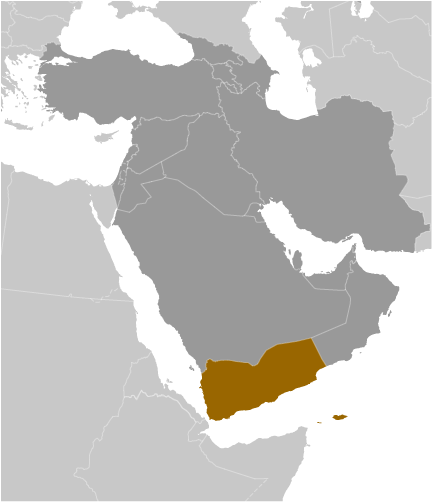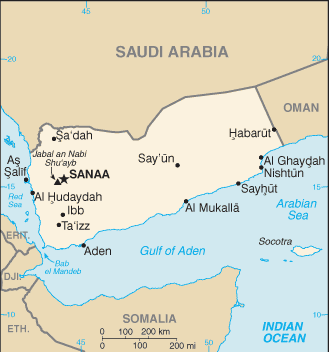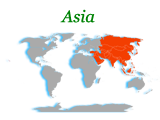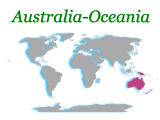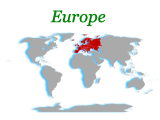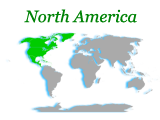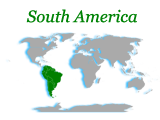North Yemen became independent of the Ottoman Empire in 1918. The British, who had set up a protectorate area around the southern port of Aden in the 19th century, withdrew in 1967 from what became South Yemen. Three years later, the southern government adopted a Marxist orientation. The massive exodus of hundreds of thousands of Yemenis from the south to the north contributed to two decades of hostility between the states. The two countries were formally unified as the Republic of Yemen in 1990. A southern secessionist movement in 1994 was quickly subdued. In 2000, Saudi Arabia and Yemen agreed to a delimitation of their border.
Country Name
Conventional long form: Republic of Yemen
Conventional short form: Yemen
Local long form: Al Jumhuriyah al Yamaniyah
Local short form: Al Yaman
Former: Yemen Arab Republic [Yemen (Sanaa) or North Yemen] and People's Democratic Republic of Yemen [Yemen (Aden) or South Yemen]
Government Type
Republic
Capital
Name: Sana
Geographic coordinates: 15 21 N, 44 12 E
Time difference: TC+3 (8 hours ahead of Washington, DC during Standard Time)
Administrative divisions
21 governorates (muhafazat, singular - muhafazah); Abyan, 'Adan (Aden), Ad Dali', Al Bayda', Al Hudaydah, Al Jawf, Al Mahrah, Al Mahwit, Amanat al 'Asimah, 'Amran, Dhamar, Hadramawt, Hajjah, Ibb, Lahij, Ma'rib, Raymah, Sa'dah, San'a' (Sanaa), Shabwah, Ta'izz
Independence
22 May 1990 (Republic of Yemen was established with the merger of the Yemen Arab Republic [Yemen (Sanaa) or North Yemen] and the Marxist-dominated People's Democratic Republic of Yemen [Yemen (Aden) or South Yemen]); note - previously North Yemen became independent in November 1918 (from the Ottoman Empire) and became a republic with the overthrow of the theocratic Imamate in 1962; South Yemen became independent on 30 November 1967 (from the UK)
National Holiday
Unification Day, 22 May (1990)
Constitution
16 May 1991; amended 29 September 1994 and February 2001
Legal system
Based on Islamic law, Turkish law, English common law, and local tribal customary law; has not accepted compulsory ICJ jurisdiction
Suffrage
18 years of age; universal
Executive branch
Chief of state: President Ali Abdallah SALIH (since 22 May 1990, the former president of North Yemen, assumed office upon the merger of North and South Yemen); Vice President Maj. Gen. Abd al-Rab Mansur al-HADI (since 3 October 1994)
Head of government: Prime Minister Ali Muhammad MUJAWWAR (since 31 March 2007)
Cabinet: Council of Ministers appointed by the president on the advice of the prime minister
(For more information visit the World Leaders website)
Elections: president elected by popular vote for a seven-year term; election last held on 20 September 2006 (next to be held in September 2013); vice president appointed by the president; prime minister and deputy prime ministers appointed by the president
Election results: percent of vote by party - NA; seats by party - GPC 228, Islah 47, YSP 7, Nasserite Unionist Party 3, National Arab Socialist Ba'th Party 2, independents 14
Legislative branch
Bicameral legislature consisting of a Shura Council (111 seats; members appointed by the president) and House of Representatives (301 seats; members elected by popular vote to serve eight-year terms)
Elections: last held on 27 April 2003 (scheduled April 2009 election postponed for two years)
Election results: the single non-transferable vote (SNTV) system used in the election did not make use of political party slates; most candidates ran as independents
Judicial branch
Supreme Court
Political Parties and Leaders
General People's Congress or GPC [Abdul-Kader BAJAMMAL]; Islamic Reform Grouping or Islah [Muhammed Abdallah AL-YADUMI]; Nasserite Unionist Party [Abd al-Malik al-MAKHLAFI]; National Arab Socialist Ba'th Party [Dr. Qasim SALAM]; Yemeni Socialist Party or YSP [Yasin Said NUMAN]; note - there are at least seven more active political parties
Political pressure groups and leaders
Muslim Brotherhood; Women National Committee
Other: conservative tribal groups; southern secessionist groups; al-Qa'ida in the Arabian Peninsula (AQAP)
International organization participation
AFESD, AMF, CAEU, FAO, G-77, IAEA, IBRD, ICAO, ICCt (signatory), ICRM, IDA, IDB, IFAD, IFC, IFRCS, ILO, IMF, IMO, Interpol, IOC, IOM, IPU, ISO (correspondent), ITSO, ITU, ITUC, LAS, MIGA, MINURCAT, MINURSO, MONUC, NAM, OAS (observer), OIC, OPCW, UN, UNAMID, UNCTAD, UNESCO, UNHCR, UNIDO, UNMIL, UNMIS, UNOCI, UNWTO, UPU, WCO, WFTU, WHO, WIPO, WMO, WTO (observer)
Diplomatic representation in the US
Chief of mission: Ambassador Muhammad Awadh Ali bin HUMAM
Chancery: 2319 Wyoming Avenue NW, Washington, DC 20008
Telephone: [1] (202) 965-4760
FAX: [1] (202) 337-2017
Diplomatic representation from the US
Chief of mission: Ambassador Stephen A. SECHE
Embassy: Sa'awan Street, Sanaa
Mailing address: P. O. Box 22347, Sanaa
Telephone: [967] (1) 755-2000 ext. 2153 or 2266
FAX: [967] (1) 303-182
Flag description
Three equal horizontal bands of red (top), white, and black; the flag retains the colors of the Arab Liberation banner
note: similar to the flag of Syria, which has two green stars in the white band, and of Iraq, which has an Arabic inscription centered in the white band; also similar to the flag of Egypt, which has a heraldic eagle centered in the white band

